
In European academic traditions, fine art is made primarily for aesthetics or creative expression, distinguishing it from decorative art or applied art, which also has to serve some practical function, such as pottery or most metalwork. In the aesthetic theories developed in the Italian Renaissance, the highest art was that which allowed the full expression and display of the artist's imagination, unrestricted by any of the practical considerations involved in, say, making and decorating a teapot. It was also considered important that making the artwork did not involve dividing the work between different individuals with specialized skills, as might be necessary with a piece of furniture, for example. Even within the fine arts, there was a hierarchy of genres based on the amount of creative imagination required, with history painting placed higher than still life.

Mummy portraits or Fayum mummy portraits are a type of naturalistic painted portrait on wooden boards attached to upper class mummies from Roman Egypt. They belong to the tradition of panel painting, one of the most highly regarded forms of art in the Classical world. The Fayum portraits are the only large body of art from that tradition to have survived. They were formerly, and incorrectly, called Coptic portraits.

The Nefertiti Bust is a painted stucco-coated limestone bust of Nefertiti, the Great Royal Wife of Egyptian pharaoh Akhenaten.
Thutmose, also known as "The King's Favourite and Master of Works, the Sculptor Thutmose", was an Ancient Egyptian sculptor. He flourished around 1350 BC, and is thought to have been the official court sculptor of the Egyptian pharaoh Akhenaten in the latter part of his reign. A German archaeological expedition digging in Akhenaten's deserted city of Akhetaten, known today as Amarna, found a ruined house and studio complex in early December 1912; the building was identified as that of Thutmose based on an ivory horse blinker found in a rubbish pit in the courtyard inscribed with his name and job title. Since it gave his occupation as "sculptor" and the building was clearly a sculpture workshop, the determination seemed logical and has proven to be accurate.

The Legion of Honor, formally known as the California Palace of the Legion of Honor, is an art museum in San Francisco, California. Located in Lincoln Park, the Legion of Honor is a component of the Fine Arts Museums of San Francisco, which also administers the de Young Museum.

Sobekneferu or Neferusobek was a pharaoh of ancient Egypt and the last ruler of the Twelfth Dynasty of the Middle Kingdom. She ascended to the throne following the death of Amenemhat IV, possibly her brother or husband, though their relationship is unproven. Instead, she asserted legitimacy through her father Amenemhat III. Her reign lasted 3 years, 10 months, and 24 days, according to the Turin King List.

A bust is a sculpted or cast representation of the upper part of the human body, depicting a person's head and neck, and a variable portion of the chest and shoulders. The piece is normally supported by a plinth. The bust is generally a portrait intended to record the appearance of an individual, but may sometimes represent a type. They may be of any medium used for sculpture, such as marble, bronze, terracotta, plaster, wax or wood.
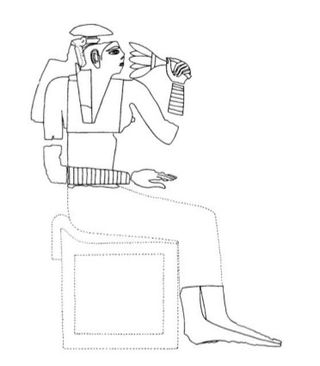
Hetepheres I was a queen of Egypt during the Fourth Dynasty of Egypt who was a wife of one king, the mother of the next king, the grandmother of two more kings, and the figure who tied together two dynasties.

Reserve heads are distinctive sculptures made primarily of fine limestone that have been found in a number of non-royal tombs of the Fourth Dynasty of Egypt; primarily from the reigns of pyramid-building pharaohs Khufu to Khafre, circa 2551–2496 B.C. While each of the heads share characteristics in common with each other, the striking individuality of the pieces makes them some of the earliest examples of portrait sculpture in existence. Their purpose is not entirely clear; the name comes from the prevalent theory first put forward in 1903 by the German Egyptologist Ludwig Borchardt, that the head was to serve as an alternate home for the spirit of the dead owner should anything happen to its body.

Ankhhaf was an Egyptian prince and served as an overseer during the reign of the Pharaoh Khufu, who is thought to have been Ankhhaf's half-brother. One of Ankhaf's titles is also as a vizier, but it is unknown which pharaoh he would have held this title under. He lived during Egypt's 4th Dynasty.

The Art & History Museum is a public museum of antiquities and ethnographic and decorative arts located at the Parc du Cinquantenaire/Jubelpark in Brussels, Belgium. The museum is one of the constituent parts of the Royal Museums of Art and History (RMAH) and is one of the largest art museums in Europe. It was formerly called the Cinquantenaire Museum until 2018. It is served by the metro stations Schuman and Merode on lines 1 and 5.

The Museum of Fine Arts of Lyon is a municipal museum of fine arts in the French city of Lyon. Located near the Place des Terreaux, it is housed in a former Benedictine convent which was active during the 17th and 18th centuries. It was restored between 1988, and 1998, remaining open to visitors throughout this time despite the ongoing restoration works. Its collections range from ancient Egyptian antiquities to the Modern art period, making the museum one of the most important in Europe. It also hosts important exhibitions of art, for example the exhibitions of works by Georges Braque and Henri Laurens in the second half of 2005, and another on the work of Théodore Géricault from April to July 2006. It is one of the largest art museums in France.
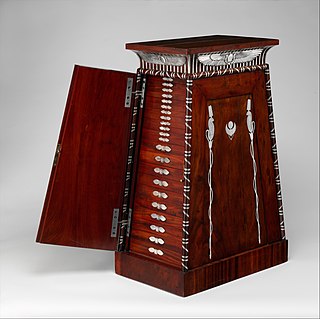
Egyptian revival decorative arts is a style in Western art, mainly of the early nineteenth century, in which Egyptian motifs were applied to a wide variety of decorative arts objects.
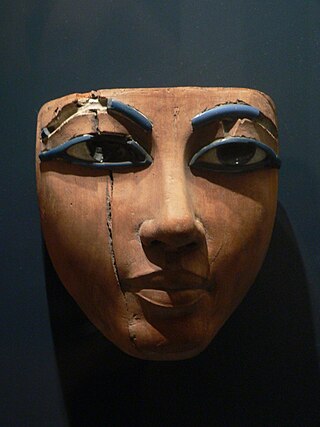
Portraiture in ancient Egypt forms a conceptual attempt to portray "the subject from its own perspective rather than the viewpoint of the artist ... to communicate essential information about the object itself". Ancient Egyptian art was a religious tool used "to maintain perfect order in the universe" and to substitute for the real thing or person through its representation.

The East Field is located to the east of the Great Pyramid of Giza and contains cemetery G 7000. This cemetery was a burial place for some of the family members of Khufu. The cemetery also includes mastabas from tenants and priests of the pyramids dated to the 5th and 6th Dynasty.
Frederick Warren Allen (1888–1961) was an American sculptor of the Boston School. One of the most prominent sculptors in Boston during the early 20th century and a master teacher at the School of the Museum of Fine Arts, Allen had a career in the arts that spanned more than 50 years.
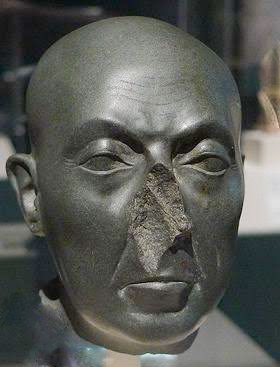
The Boston Green Head is a greywacke sculptured head of an Egyptian priest from the Late Period of ancient Egypt. The head is dated to 380–332 BC and is housed in the Museum of Fine Arts, Boston, United States.

The Statue of Sobekneferu was a sculpture of the ancient Egyptian queen Sobekneferu, who reigned during the 12th Dynasty.
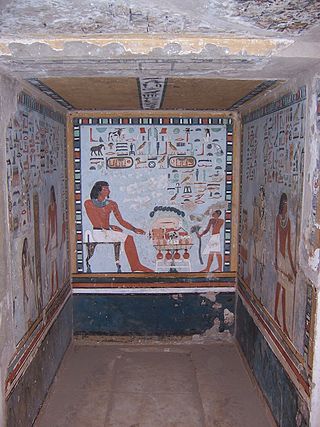
Sarenput II, also called Nubkaurenakht was an ancient Egyptian nomarch during the reign of pharaohs Senusret II and Senusret III of the 12th Dynasty.

The Passage of the Delaware is a large, Neoclassical 1819 oil-on-canvas painting by Thomas Sully. With attention to historical accuracy, the painting depicts George Washington on horseback observing the troops of the American Revolutionary Army in the process of crossing the Delaware River prior to the surprise attack on Hessian troops on December 26, 1776, at the Battle of Trenton. The image is intended to capture the moment prior to George Washington dismounting his horse and joining his army in crossing the Delaware River.
Cf. J. Assmann, Preservation and Presentation of Self in Ancient Egyptian Portraiture, in Studies in Honor of William Kelly Simpson Volume 1, pp. 55–81. Edited by Peter Der Manuelian. Boston: Department of Ancient Egyptian, Nubian, and Near Eastern Art, Museum of Fine Arts, Boston 1996.




















